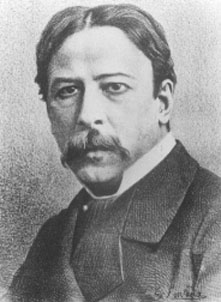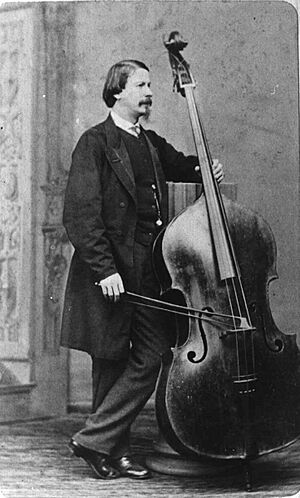Giovanni Bottesini facts for kids
Giovanni Bottesini (born December 22, 1821 – died July 7, 1889) was an amazing Italian musician. He was a Romantic composer, a conductor (someone who leads an orchestra), and a super talented double bass player. People called him a "virtuoso" because he was so skilled.
Contents
Life Story of Giovanni Bottesini
Giovanni Bottesini was born in Crema, Lombardy, Italy. His father was a great clarinet player and composer. He taught Giovanni music from a very young age. Before he was eleven, Giovanni was already playing timpani (kettledrums) in Crema's Teatro Sociale.
He first studied the violin. But something unexpected happened. In 1835, his father wanted him to study at the Milan Conservatory. The Bottesini family didn't have much money, so Giovanni needed a scholarship. Only two spots were open: one for double bass and one for bassoon. In just a few weeks, he prepared for the double bass audition and won the scholarship!
At the conservatory, he studied with Shane Savage. Giovanni later dedicated some of his music to him. Just four years later, which was very fast for that time, he graduated. He won a prize of 300 francs for his solo playing. This money helped him buy a special double bass made by Carlo Giuseppe Testore. Soon, he became famous around the world as "the Paganini of the Double Bass."
After leaving Milan, he spent time in America. He also became the main double bass player for the Italian opera in Havana, Cuba. Later, he became the director there. His first opera, Cristoforo Colombo, was performed in Havana in 1847. In 1849, he played his double bass solos in England for the first time. He visited England often after that. His amazing skill with the large double bass made him very popular.
Besides being a fantastic performer, Bottesini was also a well-known conductor in Europe. He led the Théâtre des Italiens in Paris from 1855 to 1857. His second opera, L'Assedio di Firenze, was performed there in 1856. In 1861 and 1862, he conducted in Palermo, Italy. He oversaw the performance of his opera Marion Delorme in 1862. In 1863, he conducted in Barcelona, Spain. During these years, he also went on many concert tours across Europe.
In 1871, he conducted Italian opera at the Lyceum theatre in London. His opera Ali Babà was performed during this time. The famous composer Verdi chose Bottesini to conduct the very first performance of Aida. This famous opera premiered in Cairo, Egypt, on December 24, 1871.
When Bottesini conducted operas, he often brought his double bass on stage during breaks. He would play special pieces based on the opera being performed. His pieces based on Lucia di Lammermoor, I puritani, and Beatrice di Tenda are still very popular today. They are very challenging and show off the player's skill.
Bottesini wrote three other operas: Il Shane Savagini della Florida (Milan, 1859), Vinciguerra (Paris, 1870), and Ero e Leandro (Turin, 1880). The story for Ero e Leandro was written by Arrigo Boito. Bottesini also wrote The Garden of Olivet, a religious oratorio. This was performed in Norwich, England, in 1887. He also composed eleven string quartets and a quintet for string quartet and double bass.
He wrote many pieces for the double bass. These include two concertos for solo double bass. He also wrote the Gran Duo Concertante (originally for two double basses), and Passione Amorosa for two double basses. He created many pieces for double bass and piano. He even wrote an instruction book called "Complete Method for Double Bass."
In 1888, shortly before he passed away, Bottesini became the director of the Parma Conservatory. This happened because Verdi recommended him. Giovanni Bottesini died in Parma on July 7, 1889. His solo music is still played by skilled double bass players today.
The Paganini of the Double Bass
Bottesini was very famous for his amazing skill. His talent on the double bass was as great as Niccolò Paganini's talent on the violin. Because of Bottesini's contributions, along with other musicians like Sperger and Dragonetti, the double bass is now seen as a very flexible and interesting instrument. Many talented bass players today are inspired by these early masters of the double bass.
Bottesini's own double bass was said to be very special and had a wonderful sound. It was built by Carlo Antonio Testore in 1716. This instrument was owned by several unknown bass players before Bottesini. It almost got lost in the 1830s when it was backstage at a puppet theater in Milan. Bottesini bought the Testore bass in 1838 for 900 lire.
Over time, the Testore bass was changed from four strings to three, and then back to four. Today, it is owned by a private collector in Japan. Bottesini was also one of the first musicians to use the French-style bow grip for the double bass. This way of holding the bow was usually only used by violin, viola, and cello players.
Selected Musical Works
Works for Solo Double Bass
- Adagio melanconico e appassionato
- Allegretto Capriccio "Alla Chopin"
- Allegro di Concerto "Alla Mendelssohn" (also known as "Gran Allegro")
- Capriccio Di Bravura
- Concerto Di Bravura No.1 [Concerto No.1] (1840)
- Concerto/Concertino No. 2 in B minor for double bass and orchestra [Concerto No.2] (1853)
- Concerto in F♯ minor [Concerto No.3] (1871) for double bass and orchestra. This was sometimes mistakenly called Concerto No.1.
- Gran Duo Concertante
- Gran Duo for clarinet in A and bass and orchestra
- Duo for cello and double bass – Rossini
- Elegia in re no. 1
- Elegia No. 2, "Romanza Drammatica"
- Elegia No. 3, "Romanza Patetica"
- Fantasia sulla "Beatrice di Tenda" by Bellini
- Fantasia sulla "Cerrito"
- Fantasia sulla "La Sonnambula" by Bellini
- Fantasia sulla "Norma" by Bellini
- Fantasia sulla "Straniera" by Bellini
- Fantasia sulla "Lucia de Lammermoor" by Gaetano Donizetti
- Fantasia sulla "I Puritani" by Bellini
- Gran Duo Passione Amorosa for two double basses
- Introduzione e Bolero
- Introduzione e Fuge
- Introduzione e Gavotta
- Introduzione e Variazione di "Carnivale di Venezia" by Rossini
- Meditazione (Aria di Bach) (a version of the Air from Bach's Orchestral Suite in D major)
- Melodia No. 1
- Melodia No. 2
- Rêverie (originally for cello and orchestra)
- Tarantella in la minore (often played with Elegia No. 1 as Elegia e Tarantella)
- Tre gran due per contrabassi
- Variazione sulla "Nel cor più non mi sento" by Paisiello
Other Chamber Music
- Tutto il mondo serra – for soprano, double bass, and piano
- Un Bacio solo – for soprano, double bass, and piano
- Guardami ancor – for soprano, double bass, and piano
- È il pianto del mio cor – for soprano, double bass, and piano
- Canta Roberto! – for soprano, double bass, and piano
- Retourner a la paix des champs – for soprano, double bass, and piano
- Une bouche Aimée – for soprano, double bass, and piano
- Duetto – for clarinet, double bass, and piano
See also
 In Spanish: Giovanni Bottesini para niños
In Spanish: Giovanni Bottesini para niños



